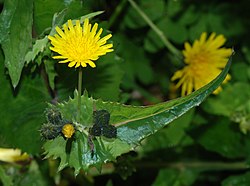Reconstruction:Proto-Sino-Tibetan/s-la
Proto-Sino-Tibetan
[edit]Etymology
[edit]

- Proto-Sino-Tibetan: ?
- Proto-Tibeto-Burman: *s-la (Matisoff, STEDT)
Cognate with *lap (“leaf”), *lep ~ ljap (“flat, thin, flat object”); see there for more cognates.
This root is the eventual source of the words for "tea" in most non-Sino-Tibetan languages of the world, mostly borrowed from Chinese 茶. Two Chinese sources of borrowing are usually distinguished:
- The affricativised varieties (e.g. Beijing Mandarin, Guangzhou Cantonese): which pronounce 茶 with an affricate initial /t͡sʰ, ʈ͡ʂʰ/.
- The plosive varieties (e.g. Min Nan) /t/.
The Chinese word might have originally been a loan from Loloish (Tibeto-Burman) *la ("leaf, tea"), as tea may have originated in Sichuan (historically Lolo-speaking area) (Sagart, 1999). Alternatively, Qiu (2000) suggests that it was a semantic extension from the root *la, which yielded 荼 (OC *rlaː, *ɦlja, *l'aː), the name of a bitter plant (Sonchus oleraceus).
Additionally, Schuessler (2007) also proposed an Austroasiatic origin for the Proto-Loloish word; as a similar-shaped etymon exists in Austroasiatic: *sla (ibid.) or *slaʔ (Sidwell & Rau, 2015); compare also Proto-Mon-Khmer *slaʔ (“leaf”) (Shorto, 2006: #230), (Modern Mon သၠ (hlaʔ, “leaf”), Khmer ស្លា (slaa, “areca palm”), ស្លឹក (slǝk, “leaf, sheet”), Vietnamese lá (“leaf”).
More at etymology of tea on Wikipedia.
Noun
[edit]*s-la
Descendants
[edit]- Old Chinese: 荼 /*rlaː, laː, ɦlja/ (ZS), /*lˤra, lˤa, l̥a/ (B-S; unlisted, theoretical) (“bitter taste vegetable; weed; white flower; poison, harm; tea”)
- Middle Chinese: 荼 /ɖɣa, ʑia, duo/, 茶 (ɖˠa) /ɖɣa/
- Chinese:
- Mandarin:
- Beijing: /ʈ͡ʂʰa³⁵/
- Central Plains: /t͡sʰa²⁴/, /ʈ͡ʂʰa⁴²/
- Dungan: ца (ca) /t͡sʰaː²⁴/
- Jiaoliao: /ʈ͡ʂʰa⁴²/
- Jilu: /ʈ͡ʂʰa⁴²/, /t͡sʰɑ⁴⁵/
- Lanyin: /ʈ͡ʂʰa⁵³/, /t͡sʰa⁵¹/
- Lower Yangtze: /ʈ͡ʂʰa⁵⁵/, /ʈ͡ʂʰɑ²⁴/
- Northeastern: /ʈ͡ʂʰa²⁴/
- Southwestern:
- Chengdu: /t͡sʰa³¹/
- Guiyang: /t͡sʰa²¹/
- Kunming: /ʈ͡ʂʰa̠³¹/
- Wuhan: /t͡sʰa²¹³/
- Sichuanese: 茶 (ca2), /t͡sʰa²¹/
- Standard: 茶 (chá), /ʈ͡ʂʰa³⁵/
- Cantonese:
- Gan:
- Nanchang: /t͡sʰɑ²⁴/
- Hakka:
- Sixian: 茶 (chhà), /t͡sʰa¹¹/
- Taoyuan: /t͡sʰɑ¹¹/
- Huizhou: /t͡sʰa⁴⁴/, /t͡sɔ⁴⁴/
- Jin: /t͡sʰa¹¹/, /t͡sɑ¹³/, /t͡sʰa³¹/
- Min:
- Wu:
- Hangzhounese: /d͡zɑ²¹³/
- Shanghainese: 茶 (zo3), /z̻o²³/
- Suzhounese: /zo¹³/
- Wenzhounese: /d͡zo³¹/
- Xiang:
- Changsha: /t͡sa¹³/
- Xiangtan: /d͡zɒ¹²/
- Mandarin:
- → Japanese: 茶 (cha), [t͡ɕʲa̠]}
- → Korean: 차 (cha), [t͡ɕʰa]
- → Tibetan: ཇ (ja, “tea”)
- Chinese:
- Middle Chinese: 荼 /ɖɣa, ʑia, duo/, 茶 (ɖˠa) /ɖɣa/
- Lolo-Burmese:
External links
[edit]- Chapter Tea in the World Atlas of Language Structures

